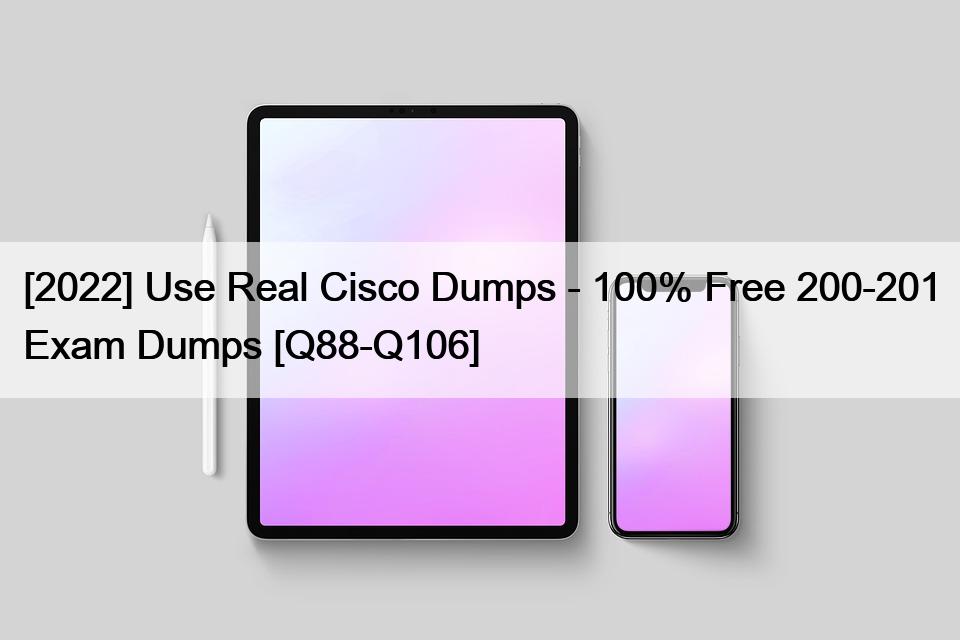[2022] Use Real Cisco Dumps – 100% Free 200-201 Exam Dumps [Q88-Q106]

[2022] Use Real Cisco Dumps – 100% Free 200-201 Exam Dumps
Realistic 200-201 Dumps Latest Cisco Practice Tests Dumps
Understanding functional and technical aspects of Cisco Cybersecurity Operations Fundamentals v1.0 (200-201 CBROPS) Host-Based Analysis
The following will be discussed in CISCO 200-201 exam dumps:
- Understanding Event Correlation and Normalization
- Interpret operating system, application, or command line logs to identify an event
- Best evidence
- Indicators of compromise
- Exploring Data Type Categories
- Chain of custody
- Understanding Endpoint Security Technologies
- Identifying Patterns of Suspicious Behavior
- Understanding Linux Operating System Basics
- Indicators of attack
- Understanding Basic Cryptography Concepts
- Describing Incident Response
- Corroborative evidence
- Assets
- Identifying Resources for Hunting Cyber Threats
- Identify components of an operating system (such as Windows and Linux) in a given scenario
- Conducting Security Incident Investigations
- Interpret the output report of a malware analysis tool (such as a detonation chamber or sandbox)
- Understanding Windows Operating System Basics
- Application-level allow listing/block listing
- Hashes
- Identifying Malicious Activity
- Identifying Common Attack Vectors
- Understanding SOC Metrics
- Understanding SOC Workflow and Automation
Exam Topics
The Cisco 200-201 exam will validate your skills and knowledge of security monitoring, security concepts, security policies & procedures, host-based analysis, and network intrusion analysis. All in all, its content comes with 5 topics that are listed as follows:
Security Concepts
This domain makes up 20% of the exam content and measures the applicants’ abilities to perform the following tasks:
- Understand CVSS – You need to have knowledge of the attack vector, privileges required, scope, and user interaction;
- Classify the difficulties of data visibility in detention;
- Describe the 5-tuple method to separate a compromised host in a grouped set of logs.
- Differentiate access control models – In this subsection, you are required to learn about discretionary, nondiscretionary, and mandatory access control, as well as authentication, accounting, and authorization;
- Compare various security concepts – As for this one, it covers the details of risk scoring, assessment, and reduction as well as vulnerability, exploit, and threat;
- Define the CIA triad;
- Determine the possible data loss from the available traffic profiles;
Understanding functional and technical aspects of Cisco Cybersecurity Operations Fundamentals v1.0 (200-201 CBROPS) Network Intrusion Analysis
The following will be discussed in CISCO 200-201 exam dumps pdf:
- Interpret basic regular expressions
- TCP
- Network application control
- Interpret common artifact elements from an event to identify an alert
- SMTP/POP3/IMAP
- Process (file or registry)
- Source address
- IPv6
- False negative
- True positive
- Payloads
- IDS/IPS
- Benign
- Interpret the fields in protocol headers as related to intrusion analysis
- Extract files from a TCP stream when given a PCAP file and Wireshark
- Map the provided events to source technologies
- Identify key elements in an intrusion from a given PCAP file
- IP address (source / destination)
- Ethernet frame
- HTTP/HTTPS/HTTP2
- Hashes
- Compare the characteristics of data obtained from taps or traffic monitoring and transactional data (NetFlow) in the analysis of network traffic
- Protocols
- Destination address
200-201 Dumps PDF – 200-201 Real Exam Questions Answers: https://www.trainingdump.com/Cisco/200-201-practice-exam-dumps.html
Related Links: bbs.wlcq180.com www.yuliancaishang.com academy.elishamamman.com 15000n-03.duckart.pro andicreative.com www.pcsq28.com
Leave a Reply